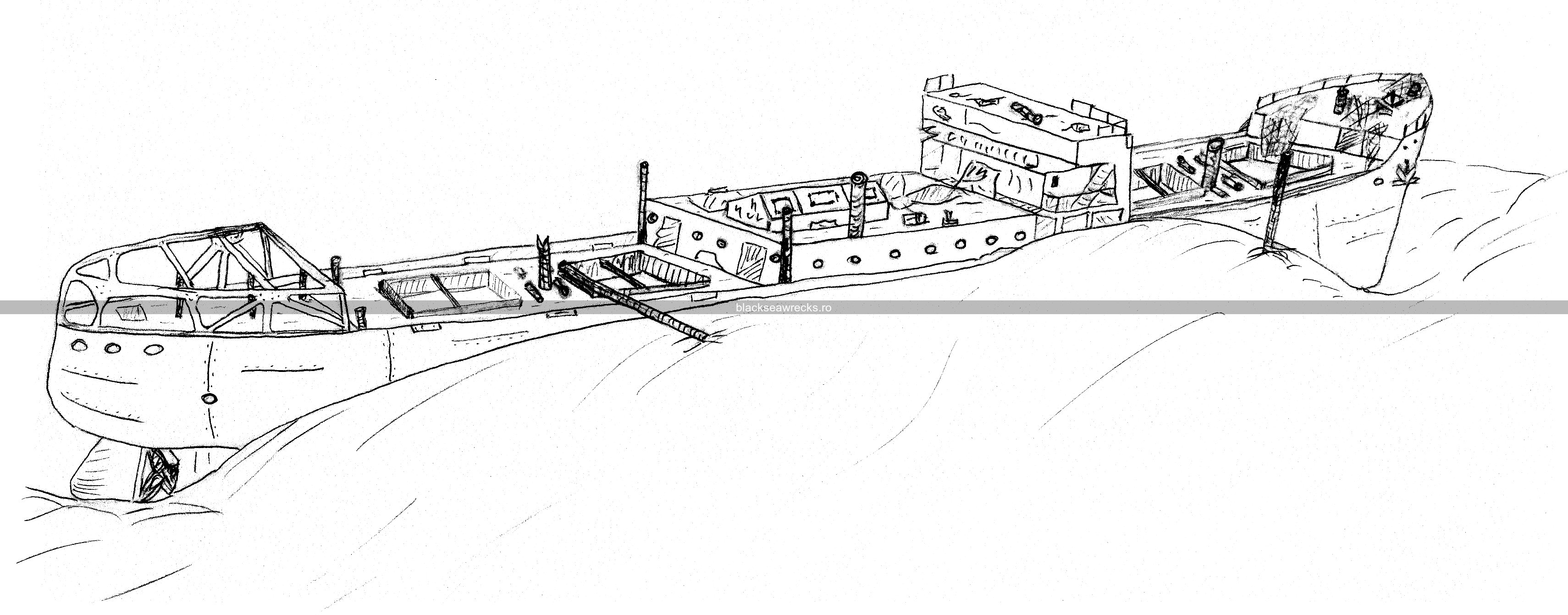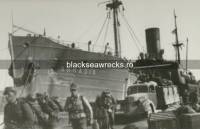Arkadia
| Type | Cargo |
|---|---|
| DWT | 1756 |
| Length | 84.15m |
| Beam | 12.85m |
| Draft | 4.90m |
| Crew | ? |
| Cargo | probably empty |
| Builder | Aktiengeselschaft Neptun AG, Rostock |
| Flag | German |
| Sink date | 29 April 1943 |
| Sink reason | mine explosion |
| Survivors | all |
| Coordinates | N44 18.452 E028 48.419 |
| Depth | 17-31m |
Discovery
 Arkadia was probably found by the Romanian Navy in the 1980s. Upon the discovery it was thought its name is Bremen, because of the bell, which was recovered by the Navy and now sits on one of its vessels. Unfortunately there was no ship named Bremen known to be sunk in the Black Sea.
Arkadia was probably found by the Romanian Navy in the 1980s. Upon the discovery it was thought its name is Bremen, because of the bell, which was recovered by the Navy and now sits on one of its vessels. Unfortunately there was no ship named Bremen known to be sunk in the Black Sea.
By studying the Lloyds register, Harry Bakker discovered that there was a ship called Amsel (and later renamed to Arkadia), with the port of call Bremen, corresponding to the names inscribed on the bell.
History
 The ship was built in 1926-1927 at Neptun AG, Rostock(english translation). The yard number was 409, and the keel was laid in 1926. The ship was launched in June 1927, and the first owner was North German Lloyd.
The ship was built in 1926-1927 at Neptun AG, Rostock(english translation). The yard number was 409, and the keel was laid in 1926. The ship was launched in June 1927, and the first owner was North German Lloyd.

In probably one of the first voyages, the ship departed from Bremen on November 12, 1927, bound to Santa Cruz de Tenerife, Spain, carrying 3 passengers aboard: Helene von Schweinichen (age 60, Hannover), Rudolf Queisser (age 26, Hamburg), Wilhelm Haevernick (age 36, Kiel).
In 1922, Roland Linie AG purchased Argo AG(english translation) and one year later, Roland was acquired by North German Lloyd. Following the 1933 reorganization of North German Lloyd, Argo Reederei was spun off as an independent company. Since July 1934, Amsel belonged to Argo Reederei.

 Following further reorganization of the German maritime companies by the Reich, Atlas Levante Linie(english translation) was founded on 26th July 1935, and ships from North German Lloyd and Argo Reederei were transferred to the new company. Amsel was one of the ships transferred to Atlas Levante Linie in August 1935.
Following further reorganization of the German maritime companies by the Reich, Atlas Levante Linie(english translation) was founded on 26th July 1935, and ships from North German Lloyd and Argo Reederei were transferred to the new company. Amsel was one of the ships transferred to Atlas Levante Linie in August 1935.

Amsel was renamed Arkadia in April 1936.

Between 1939 and 1943, the ship operated in the Black Sea and the Aegean. In June 1941, it took part in the invasion of Crete, transporting troops.
On May 8, 1941, Arkadia passed Istanbul bound for the Aegean, transporting 6100 bombs and a large number of small rubber boats, according to the “British War Cabinet's Weekly Resume no. 90 of the naval, military, and air situation from May 15th to May 22nd”.
Between 1941-1943 it was attacked at least three times by Russian submarines.
On 29 April 1943, at 09:33, according to the KTB log of R33, because of a navigation mistake, while en route from Sevastopol to Constanta, under escort by 4 German R-boats (R33, R36, R37, R165), it hit a mine from the S-57 Romanian minefield, and sunk. The crew of Arkadia was saved by the R-boats. Later on the same day, at 15:00, R36 returned to mark the spot, and hit another mine, but was able to be towed back to the harbour. Later, in June, R36 was sent up the Danube to Linz for repairs.
As a side note, the commander of the 3rd flotilla of R-boats (to which the R33, R36, R37 and R165 belonged) was Helmut Klassman.
Diving
 The wreck is lying upright on a sand bed at a depth of 31 meters. It is very easy to find your way on the wreck, as the port side is completely exposed, while on the starboard side the sand is reaching the deck level. The deck is at a depth of ~25 meters.
The wreck is lying upright on a sand bed at a depth of 31 meters. It is very easy to find your way on the wreck, as the port side is completely exposed, while on the starboard side the sand is reaching the deck level. The deck is at a depth of ~25 meters.
Interesting points on the wreck are:
- The ship's big propeller, partially buried in the sand at -31m;
- The huge helm on the deck, inside the stern upper structure;
- A spare propeller stored at the stern;
- Central upper structure, with interesting penetration options;
- The impressive, completely out of the sand, bow.
 The wreck is currently suffering from visible degradation year by year from the winter storms. The highest upper part of the cabin is already gone. The ship's galley (which was a pretty daring penetration in 2010) can be entered very easily from the bow side.
The wreck is currently suffering from visible degradation year by year from the winter storms. The highest upper part of the cabin is already gone. The ship's galley (which was a pretty daring penetration in 2010) can be entered very easily from the bow side.
Harry Bakker recovered a bronze helm which was buried in debris on the upper part of the main cabin. The helm is now on display at the Navy Museum, in Constanta.
In 2014, Victor Stanescu discovered, cleaned of barnacles and photographed an interesting water filter (surprisingly, the company who manufactured it still exists and it is now owned by Veolia). Unfortunately it is no longer on the wreck - somebody took advantage of finding it clean of mussels and easy to spot, and took it away.






